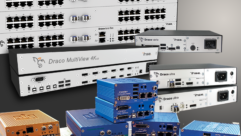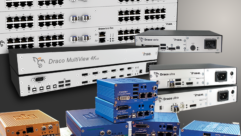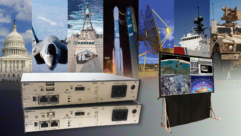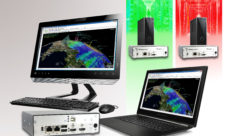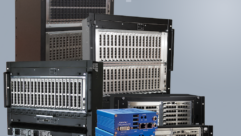
Technology Showcase:
KVM Extenders
Jun 1, 2006 12:00 PM,
By Bennett Liles
Switches evolve into big-time network management.
Aten Technology CE250
Almost as soon as desktop computers started showing up, there came a need to manage the clutter of multiple CRT monitors, keyboards, and mice. Necessity soon mothered the invention of the keyboard video mouse (KVM) switch. These first models simply connected the three common peripherals to two desktop workstations, but as racks of servers sprouted, technicians saw the advantage of a more sophisticated level of distributed control that would conserve valuable rack space. Since then, KVM technology has evolved right along with computer networks, and, as these networks have morphed into LAN and WAN applications spanning increasingly wide physical areas, the need for control extension devices has come to the forefront. First, let’s look at the various flavors of KVM.
LOCAL ANALOG
The primary difference in KVM systems relates to the keyboard-to-computer distance that needs to be covered and the number of computers to be controlled. The simplest analog models can make hardware connections within a few dozen feet and are primarily used when one user needs access to several local computers. The most sophisticated and expensive systems in this regard involve network control center server racks where IT techs require quickly switched access to many servers, usually one at a time. Cable runs are less than 1,000ft., and the analog control signals are out-of-band. That is, they do not rely on the bandwidth of servers or their networks because they connect directly as hardware peripherals, just like a single keyboard, mouse, and monitor attach to a single computer. The only security issue, therefore, is physical access to the KVM peripherals. There is no way this simple KVM system can be hacked from the outside; however, the local system may be connected to an IP gateway for much more distant access, which will introduce network security issues.
Two key capabilities of better local analog KVMs are proper emulation of the necessary peripherals for all connected computers and delivery of the necessary video resolution. The switch must be able to deliver the video resolution that the computer is trying to provide to the monitor, and this ability tends to degrade with distance. To a degree, better cable buys more distance for a given signal. Many operating systems, particularly Windows, will not boot normally if they don’t see the properly connected peripherals while running through the initial POST (power-on and self-test) routine. A good KVM switch will provide “keep-alive emulation” for all connected machines, regardless of which one is currently selected. Switching is typically done with a hardware button on the unit or, with rackmounted hardware, a key combination on the keyboard such as hitting the scroll lock several times. Some also feature OSDs (onscreen switching displays) and Windows-style configuration and operating software.
KVM OVER UTP AND FIBER

Gefen CAT5-9000HD
When the control scenario spans multiple rooms, KVM over Cat-5 comes in. This is not to be confused with KVM over IP, although the two terms are frequently interchanged. KVM over Cat-5 simply extends the same out-of-band analog control signals up to several hundred feet over UTP cable with small KVM extenders on each end of the Cat-5 run. One device in the pair transmits mouse and keyboard commands, while receiving monitor video. The other performs the opposite functions. These devices have evolved into units that can also extend USB, serial ports, and even speaker lines, so a multitude of peripheral devices can be shared by machines. In the age of webcasting and videoconferencing, some extender products carry microphone and speaker lines right along with those for the control signals.
A logical and physical extension of this scheme is KVM over fiber, in which the extenders perform the same functions to increase the range of the control signals to several miles. An important factor in this method of KVM extension is that we are still discussing out-of-band solutions. These do not share the bandwidth that servers use to transmit and receive their network data, a factor that carries both economic and security ramifications. Out-of-band KVM access allows BIOS-level access to servers even when they are down, but in-band KVM access over the corporate network doesn’t work after the server crashes, unless a backup control connection is available via modem. The fiber-extension option carries substantial cost, but it also provides the benefit of being impervious to RFI/EMI problems generated by strong radio transmissions, AC motors, and medical MRI equipment.
KVM OVER IP
This is often confused with KVM extension over UTP or fiber, but it has a very basic difference. This represents the digital, in-band solution to far-flung KVM control. The KVM control signals are shared with the network data to offer much more versatility in one-to-many and many-to-one access schemes. The other primary advantage with KVM over IP is that, because it uses the same conveyance as Internet data packets, its control reach is extended to a worldwide realm. Of course, this presents similar security caveats as are native to the usual IP data, and naturally it requires the same encryption, authorization, and authentication mechanisms to avoid compromising the KVM control signals. An additional concern is that since the control signals are in-band and share the data stream with other content, response latency in the form of mouse lag may be noticed particularly during high traffic periods. A very useful feature provided by this KVM method is activity logging.
EMBEDDED KVM OVER IP

Network Technologies Xtendex ST-C5KVM-600
The newest variant of KVM control is one that uses hardware that is built in as an integral part of the server, and, while the switches are no longer discrete KVM devices themselves, they offer several significant advantages. Access to power controls and other basic functions is provided through a baseboard management controller that operates independently of the main processor and uses auxiliary power for a completely separate server control solution.
WHICH IS BETTER?
So, let’s break down the positives and negatives. Analog KVM is network-independent, while digital shares the data stream. Analog video and control response is fast, while digital may display some mouse latency. Analog solutions maintain BIOS-level control when the network is down, and security is generally easier to maintain with the analog, out-of-band scheme. Analog will also usually allow more simultaneous, non-blocked users. Digital KVM solutions enable a worldwide reach for control and provide easier scale-up through existing hardware. When the system is expanded, however, digital KVM schemes can use existing network cable while analog expansion will require additional RGB and PS/2 cabling. Embedded KVM over IP offers the ultimate in cold crash control with its ability to turn servers on and off while it operates on auxiliary power. Which is best involves questions on plant size, proximity of control consoles, type of cabling desired, the number of simultaneous users, and the need for security. The common thread is that these have all increased the physical reach of server control in various steps using KVM extension technology. Let’s have a look at what’s out in the field of devices used to extend this control and monitoring capability.
THE MARKET
Today, extenders are available for every type of KVM signal, and many modern products combine several types of control and monitoring signals. While only one product from each company is mentioned, most of the manufacturers listed here provide products across the entire range of analog and digital KVM extension including USB, serial, and audio signals.

Adder Technology AdderLink X2-Multiscreen extender
Among Adder Technology’s many KVM products is the AdderLink series X2-MultiScreen extender for conveyance of multiple, high-resolution video displays, keyboard, mouse, multiple RS-232, and audio signals up to 1,000ft. over Cat-5 and higher UTP cable, and it includes an additional feed-through port for local control. 1280×1024 video is available at distances up to 1,000ft. with automatic signal compensation. The X2-MultiScreen supports flatscreen and CRT monitors, and it handles microphone signals. The RS-232 support enables the use of touchscreen monitors. Hotkeys are used to access the configuration mode and the password security allows the keyboard to be locked. Panel lights indicate keyboard and mouse activity as well as link status. Operating system compatibility includes Windows 9X, NT, XP, 2000, Netware, RS6000, DOS, OS/2, and UNIX. Features include spike suppression and flash upgrades.
The CE250 KVM console extender from Aten Technology allows computer and KVM switch operation from a distance of up to 500ft. over Cat-5e UTP cable with Automatic Signal Compensation to set the right signal level for cable length. The product also features push-button selection between local and remote units, automatic gain control, and video support for VGA, SVGA, and Multisync monitors at resolutions up to 1024×768 at a maximum of 492ft. The front-panel button cycles the local unit through its local and auto modes of operation and LEDs indicate operating status. The Aten CE250 local and remote pair can be purchased for less than $250.
Avocent offers the LongView and LongView Companion KVM extender family for control extension of keyboard, video, mouse, stereo speakers, microphone, and serial ports for distances up to 500ft., including bidirectional stereo sound. Using separate AC power supplies, the LongView transmitter and receiver pair carries these signals to their destination over Cat-5 UTP cable. Auto Tuning technology provides automatic signal compensation to suit cable length, data rate up to 19.2Kbps and video resolution up to 1600×1200. Two users may control the same computer at any time, but only one may enter data at any specific moment. Keep-alive emulation allows non-selected computers to perform glitch-free booting. The LV-420 transmitter/receiver pair with these capabilities lists for $595.
In the KVM over IP realm, Belkin offers the Enterprise Quad-Bus series Remote IP Console (RIPC) for TCP/IP control extension. With Microsoft Explorer 5.5 or higher, one digital user can access servers at BIOS level through 256-bit SSL encryption for operations, including hardware functions and power. As new platforms come online, Flash upgrades will keep the hardware up to date for free for the life of the unit. The RIPC supports PS/2 mice and keyboards. Features include user-defined hot keys, power-off VGA video emulation, and support for two serial devices. Connection status and activity are monitored with front-panel LEDs. The RIPC retails for around $1,000, and there is no software to install.
At the light end of its impressive range of KVM products, Daxten makes the Voyager Micro for KVM signal extension at short distances up to 229.66ft. on a single Cat-5/6 cable. For situations in which the smallest hardware is best, the Voyager Micro provides a simple, software-free solution to PS/2 extension and support for video resolutions up to 1600×1200 at 75Hz. The user may specify PS/2 or USB for the transmitter and the USB model works with a variety of operating systems including Windows 98 and up, Sun, SGI, and Mac. If your KVM extension requirements are light, the Daxten Voyager Micro lists for $259.

Belkin Remote IP Console
Fujitsu markets the Servis Cat-5 extender for remote server control with audio support at distances up to 656.17ft. with XGA video resolution on UTP cable. The unit includes a KVM pass-through for a local switch. Audio quality up to 20KHz in frequency response is handled through a 16-bit digital audio converter with 44.1KHz sampling. Local and remote units feature PS/2, USB, and Sun I/O interfaces for keyboard and mouse along with audio on two balanced XLR connectors (stereo mini for output) and RGB video port. Through BIOS-level IP access via the Web, hardware and power functions can be reset, while 256-bit SSL encryption ensures security. Features include user-defined hotkeys, Flash upgrades, and power-off video emulation. The unit’s MSRP is $998.
Another notable entry in the field of KVM extenders with audio support is the Gefen CAT5-9000HD. This pair of terminals digitally extends HDCP-compliant DVI video with HDTV resolution up to 150ft. along with USB or PS/2 mouse and keyboard, RS-232 serial, and two audio devices over multiple Cat-5e cables. Each unit comes with a 5V DC power supply, uses a maximum of 20W, and is housed in a metal case for RFI shielding. One UTP cable extends Audio 2, another extends RS-232, and PS/2, while a third Cat-5 line carries video, USB, and Audio 1 signals. Audio connects to the local computer through a mini terminal. Picture sharpness, resolution, and refresh rate is set with internal jumpers. The CAT5-9000HD lists for $1,195.
Introduced at InfoComm this month, the U97-H2 from Hall Research Technologies serves the trend toward dual monitors with the capability to extend keyboard, two monitors, audio, and RS-232 serial control to a local station and a remote station up to 500ft. away on two UTP cables. The sender unit can allow either or both units to control, and digital video signal compensation can be adjusted separately for each monitor through keyboard hotkeys. The sender indicates with LEDs which unit has control and an LED on each unit indicates a good connection between the two. Two seconds after any input, either station can send commands. After the video compensation hotkey sequence is entered, plus and minus keys can be used to adjust for optimum video. The MSRP on the U97-H2 dual-monitor KVVM extender is $950.
For console-to-switch distances up to 500ft., the Iogear GCE250 Cat-5 KVM console extender can provide plug-and-play performance. The local and remote units each provide control. The GCE250 features Auto Signal Compensation, which senses the cable length and automatically adjusts the signal strength to match the distance, thereby eliminating any manual setup for this on DIP switches. Push-button selection of local or remote consoles results in an LED indication on the face of the unit. In local mode, the local console has exclusive control of the system. In auto mode, the local and remote consoles share control. No software installation is needed, and the GCE250 supports video resolution up to 1280×1024 in VGA, SVGA, and Multisync monitors. Each pair of local and remote extenders lists for less than $300.
Minicom Advanced Systems offers a local KVM extension solution in an incredibly small package. The Mini KVM Extender allows connection of PS/2 consoles to Sun, USB, and PS/2 platforms up to 230ft. away on Cat-5. The transmitter and receiver are so small they can be placed virtually anywhere for a practical add-on solution for existing KVM installations. The transmitter is powered from the keyboard port, so only the receiver needs external power. Depending on cable length, the pair supports video resolutions up to 1600×1200 at 75Hz. Plug-and-play performance is ensured with this strictly hardware product. It’s the smallest and simplest way to go. The Mini KVM Extender pair retails for around $150.
For KVM extension over Cat-5 with built-in surge protection, Network Technologies (NTI) markets the Xtendex ST-C5KVM-600. Consisting of a local and remote unit, the extender pair allows KVM control over UTP for distances up to 600ft., with video resolution up to 1920×1440 and automatic video quality adjustment for cable length. Options include nine-pin D connector for RS-232 control (not available on ST-C5KVM-600) with baud rate up to 56k and 0.14in. stereo mini plug for audio signals, an important feature for multimedia applications. Keep-alive keyboard and mouse emulation provides trouble-free booting. The local unit provides support for connection to PC, Sun Fire V20z, or NTI switch. With RS-232, touchscreen monitor support is available. Each pair retails for less than $400.
Raritan offers a fiber KVM extension product for increasing the reach of console control up to six miles on single-mode fiber (0.34 miles on multi-mode) with the FR2000 FiberReach II. The transmitter/receiver pair connects with two strands of single-mode or multi-mode fiber-optic cable on SC-Duplex connectors to provide a control solution free of EMI/RFI problems and power surges. Video resolutions up to 1280×1024 at 60Hz are supported and keep-alive emulation assures that servers are always ready to serve. Raritan adapters facilitate compatibility with a wide range of platforms. The fiber-link status is monitored with front-panel LEDs. The FiberReach II pair lists for less than $3,500.
For more local applications at a moderate price, Rose Electronics markets the CrystalView Mini USB Cat-5 KVM extender. USB keyboards and mice can be used with this extender pair and dual-head VGA to UXGA video modes are supported over Cat-5 UTP. Microprocessor-controlled keep-alive emulation allows non-selected servers to boot properly regardless of the operating system. You can customize the extender for your specific application through a selection of four feature-specific models available in single-video, dual-video, single-video with serial/audio, and dual-video with serial/audio. Stereo sound may be transmitted in both directions simultaneously and the remote unit includes a four-port USB hub. The serial port models offer direct touchscreen connection. All these features come in a compact case less than 5in. wide.
For More Information
Adder Technology
www.adder.com
Aten Technology
www.aten-usa.com
Avocent
www.avocent.com
Belkin
www.belkin.com
Daxten
www.daxten.com
Fujitsu
www.fujitsu.com
Gefen
www.gefen.com
Hall Research Technologies
www.hallresearch.com
Iogear
www.iogear.com
Minicom Advanced Systems
www.minicom.com
Network Technologies
www.networktechinc.com
Raritan
www.raritan.com
Rose Electronics
www.rose.com


